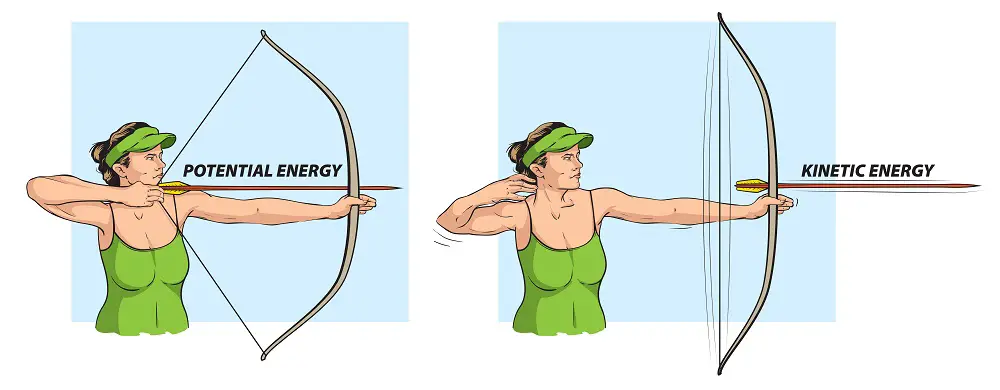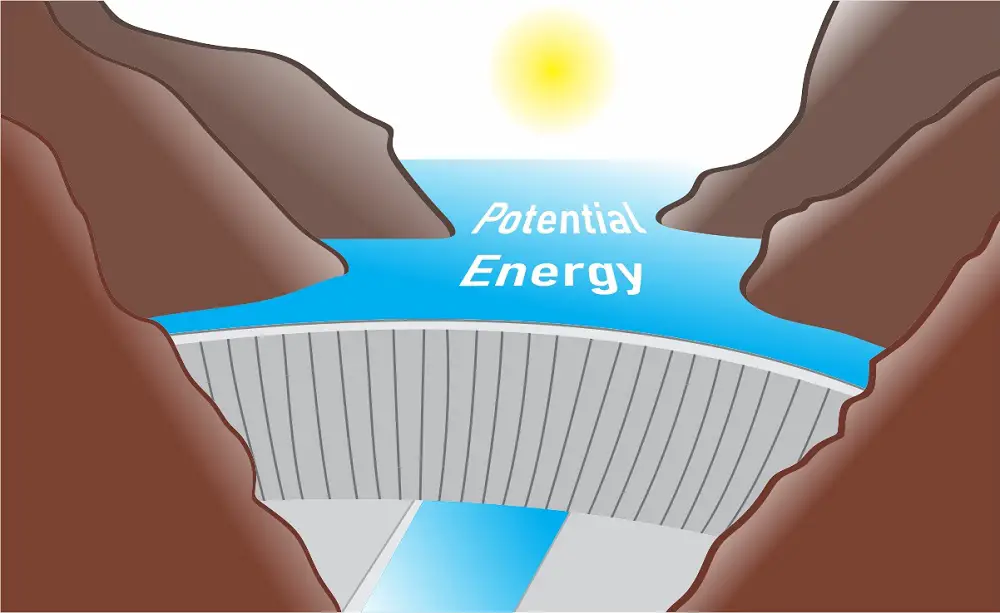There are two types of mechanical energy – kinetic energy and potential energy. Any physical object or thing can have mechanical energy, as we shall see in the examples below.
Mechanical Energy Type 1 – Kinetic energy

Kinetic mechanical energy is energy that is stored in something by the fact that it is moving. The movement can either be something turning round (rotational kinetic energy) ; something moving along in a straight line (linear kinetic energy) or vibrational kinetic energy.
Just by being in motion, an object is said to possess kinetic energy. The amount of kinetic energy something has depends on only two things – how heavy it is, and how fast it is moving.
Scientists use the equation E = ½mv2 to find out how much kinetic energy something has.
‘E’ means the kinetic energy, ‘m’ (mass) means the weight of the object1 (measured in kilograms) and ‘v’ (velocity) means the speed it is moving at (measured in metres per second). So to find the amount of kinetic energy something has, you take the mass of the object, multiply it by the square of its velocity (v2 means velocity multiplied by velocity), and then half that number. That is the amount of kinetic energy it has.
If you double the weight of an object, so its kinetic energy also doubles. But if the object’s speed doubles, its kinetic energy goes up by four times, because of the squaring. Also, if an object has a speed of zero, it will have zero kinetic energy, no matter how heavy it is.
Examples of Kinetic Mechanical Energy
1. A car driving along a street
Because the car is moving, and it also has a weight, it must therefore have kinetic energy. If the driver takes their foot off the accelerator and puts the car into a neutral gear, the car will continue to move, powered by the kinetic energy in the car.

Wind resistance and friction from the road will cause the kinetic energy in the car to gradually get less and less, and the car will keep slowing down until all the kinetic energy has been used up, when it will stop completely.
2. A bowling ball rolling down a bowling alley
Again, the ball has a speed and a weight, so it has kinetic energy. That energy keeps the ball rolling along the alley. When it hits the pins, some of the kinetic energy in the ball gets transferred into them, causing them to accelerate quickly and shoot off in different directions.
3. Water flowing in a river
This one is not so obvious, but the water flowing in a river does have a weight (quite a lot in a large river!) and it is moving, so the water itself has kinetic energy.
Tidal water movements through coastal channels also have a lot of kinetic energy for the same reason. This potential energy can be captured using water wheels and tidal turbines, where it is converted into rotational kinetic energy to be put to use (e.g., for milling or generating electricity).
4. Bullet fired from a gun
Bullets weigh very little (low mass) so you would think that they don’t have much kinetic energy, but because their velocity is so high and due to the squaring, bullets actually contain a huge amount of kinetic energy. The kinetic energy contained in a bullet means it is very hard to stop, and it will penetrate many other kinds of objects. For a bulletproof material to bring a bullet to a complete stop, it has to absorb all its kinetic energy in one go.
5. Wind
Another one that’s not so obvious: air itself actually has mass, and so large volumes of air moving around (commonly known as wind!) actually has kinetic energy. This kinetic energy can be transferred into a wind turbine through its blades, where it is stored as rotational kinetic energy.

5. A person walking or running
When you walk or run, chemical energy that is stored in your body is converted into kinetic energy as you move. The faster you run, the more chemical energy is converted into kinetic energy, and the more tired you feel!
6. A flywheel spinning round
A flywheel is a large heavy wheel designed to store kinetic energy. They were commonly used in old steam engines to stabilise the jerky motion from the output of the steam driven pistons. Because they are heavy, flywheels take a lot of energy to get going, but once they’re spinning, they contain a lot of kinetic energy.
Mechanical energy type 2 – Potential energy
Potential energy is energy that can make something move, even though it’s not moving right now.
Examples of Potential Mechanical Energy
1. A stretched spring
As a spring is stretched out, it gains potential mechanical energy in the form of strain in the spring. The strain wants to make the spring return to its original shape. The more it is stretched out, the more potential energy it stores, and the harder it becomes to stretch it further.

When it is released, the potential energy is given out as it returns to its original shape. If a spring is stretched too far, it goes past what is called the spring’s elastic limit and the spring’s material (metal or plastic or whatever the spring is made of) fails, meaning it will never return to its original shape.
2. A roller coaster carriage at the top of a hill about to go down it
Roller coaster carriages are lifted up to the top of the lift hill using a chain. Kinetic energy is transferred into the carriage from the chain, and as it gets higher, the carriage has more and more potential energy.
This kind of potential energy is also called gravitational potential energy, because it relies on gravity to pull the carriage down once it has reached the top of the hill.
3. A bent bow about to fire an arrow

In a similar way to a stretched spring, a bent bow stores potential energy in the strain of the bow as it wants to return to its usual shape. When the archer releases the bow string, the potential energy in the bow is converted into kinetic energy in the arrow, causing it to fly towards its target.
4. Water in the upper lake behind a hydroelectric dam

In another example of gravitational potential energy, the lake of water behind a hydroelectric dam has potential energy, due to the fact that it is higher up than the outlet on the other side of the hydroelectric dam.
When the sluice gates are opened, gravity causes the water to flow out of the upper lake down through the internal pipes, whereupon the potential energy is converted into linear kinetic energy in the water.
The water flows through the generation station, where its kinetic energy is converted into rotational kinetic energy in hydroelectric turbines, and from there into electrical energy.
Footnotes
1. The term ‘weight’ is commonly used by many people when talking about an object’s mass. There is a subtle but important difference between an object’s mass and its weight, but since we are talking about mechanical energy at the earth’s surface where gravity is constant, I am using the two terms interchangeably - https://cosmosmagazine.com/

